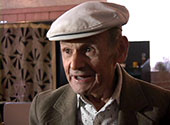
David Vider was born in 1922 in the town of Sighetu Marmatiei (north-western Romania) to a Hasidic family, followers of the Botoshaner Rebbe. Vider had five siblings. After finishing yeshiva, Vider’s father Avrum-Mayer served four years in the Austro-Hungarian army and was wounded during the First World War. During his life, he worked many jobs as a shoykhet (ritual slaughterer), melamed (religious teacher), and a khazn/bal-tfile (cantor and/or prayer leader). Vider’s father and brother were killed during the Second World War. Vider's mother was a women's prayer leader in the synagogue. Vider's father educated him at home, teaching him the Jewish alphabet and basic prayers before he started school. At the age of three, David with his family moved to Hîrlau, where he attended Jewish school, studying in Yididsh in the morning and in Hebrew in the afternoon. Around the age of twelve, Vider's family moved again to Iasi, where Vider received his formal traditional religious education in the Beys-Arn Yeshiva. In his youth, David was a member of the Gordonia Zionist group. After studying for three years to become a tailor, in 1940 Vider moved to the Soviet Union to earn a better living. At the age of eighteen, he began working in a mining town in the Urals and then worked for some time as a mechanic in the Garagum (Kara-kum) desert in Turkmenistan. During the war, Vider worked in the oil fields in Turkmenistan. Later, he worked in a mine in the L’viv area, staying there until the age of seventy, at which time he retired to Kolomyya. Vider was married twice. His first wife was a communist Jewish woman, while his second wife is a Christian woman from Kolomyya.
Nuts
Kolomyya, Ukraine
In Soviet times, while public displays of Jewish observance were heavily discouraged by state authorities, many Jews held on to the traditions of Passover, such as clandestinely baking and eating matzah. More than most other Jewish practices, Peysekh customs persisted among Soviet Jews, in part because of the symbolic content of the holiday's message of national liberation, and because of the memory of participation in the Seyder as children.
In the early years of the Soviet Union, the Jewish Sections of the Communist Party published so called Red Hagaddahs that tried to retell the Passover story as a story of the liberation of the proletariat from the oppression of the bourgeoisie. These Red Hagaddahs were widely distributed through Communist Party youth organizations. Almost none of the people we interviewed remembered the Red Hagaddahs. Instead, they recall traditional seders with their families, but often have difficulty recalling specific details of the ceremony. Dovid Vider was born in 1922 in Sighetu Marmatiei (in present-day Romania). He received a traditional religious education in a yeshiva in Iasi, Romania. In this clip Dovid describes games which children would often play during Passover.
Because Jewish children in Eastern Europe could often not afford elaborate toys, they would invent games that required only everyday items as props, such as nuts (often walnuts). This game used eight nuts, equivalent to the eight days of Passover and of Sukkoth, the other occasion when the game was played.
